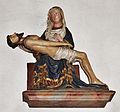Parish Church of St. Martin (Villach)
The parish church of Sankt Martin stands on a hill on the right bank of the Drau in Villach .
history
The church hill of St. Martin was already settled in Roman times. Probably soon after 800 a church for the Franconian court was built here, which was consecrated to the Franconian national saint Martin . In 979, the Villach court's own church was named, probably St. Martin. After 1007 a Bamberg own church was mentioned. An ecclesia S. Martini was first mentioned in a document in 1197. The elevation to the parish took place in 1244. After the church was Protestant for a long time in the 16th century , the Counter Reformation was carried out in 1594 . In the Baroque period, the porch and nave windows were redesigned and the onion dome was built. In autumn 1916 landslides occurred behind the church and four meters of the churchyard wall fell into the depths. The church tower collapsed on June 24, 1962 when a sacristy was reconstructed, damaging the nave and transept. Numerous Roman-era inscriptions and relief fragments were found in the rubble, which are now in the Villach City Museum . During the reconstruction by Ernst Ranner, the nave was widened.
Until 1752 St. Martin belonged to the Patriarchate of Aquileja , then to the Archdiocese of Gorizia and from 1786 to the Diocese of Gurk . For a long time the parish area also included the area of Bleiberg-Kreuth , the Dobratschrücken and the entire area between Drau and Gail with the exception of Villach within the city walls and the St. Peter / Perau church. After St. Martin was incorporated into the city of Villach in 1905, it was elevated to the status of a parish in 1908. In 1952, Auen von St. Martin became independent and the parish of St. Josef was established, Völkendorf, Möltschach and Judendorf were also separated and in 1981 the parish of the Holy Trinity was established.
Building
The church is a single-nave building with side chapels that look like the arms of a transept from the outside, and a retracted choir. The massive tower stands in the southeast corner between the nave and the south chapel. In the open two-bay vestibule there are tombstones, including a coat of arms slab from 1539. Before the tower collapsed, the Romanesque nave walls and the Romanesque tower were the oldest parts. The late Gothic barrel-vaulted choir has a 5/8 end . The two transept-like chapels have a groin vault.
Facility
The Baroque high altar is a created by Joseph Preimbl 1778 aedicula -Altar with blasted wave gable. The altarpiece shows the legends of St. Martin. The two statues above the sacrificial passage portals, Peter on the left and Paul on the right , were created by Johann Mayer. The altarpiece is made up of a three-dimensional trinity group and angel figures.
The north transept altar was built around 1670. It consists of an aedicule with a staggered double column over a small base. The altarpiece is a blasted segmented gable with a rich cartilage cartouche . There is more cartilage on the base and in the entablature. The altar shows a protective cloak Madonna with child and two angels spreading the cloak. This wooden relief was created around 1510 and is attributed to Master Heinrich von Villach.
Is on the eastern wall of the transept a simple altar from the mid-18th century in white gold setted tabernacle . The image represents the death of St. Joseph . The altar is now used as a sacrament altar. The cross altar on the east wall of the south transept was also made in the middle of the 18th century. His picture shows the crucifixion of Jesus.
A baroque Ecce homo and a Vesper picture (Pietà) from around 1420 in the soft style are available as console figures . The modern baptismal font is crowned by a baroque baptismal group .
On the south wall of the nave hangs a wide-format painting, which was probably painted by Anton Blumenthal in 1580 . It is the repetition of the panel painting of the same theme from 1540, which is now attached to the organ gallery. The older image was covered by the younger version and was only discovered in 1962. Both pictures show the Reformation motif of law and grace , an allegorical juxtaposition of the Old and New Testaments. The Old Testament is symbolized by the brazen serpent , the grace of God by the crucified one and the resurrection.
The organ was rebuilt in 1999.
Georg Becherer's bell is marked “1611”.
Chapel of St. Michael
The late Gothic chapel to the south of the church is a simple two-bay building built in the 15th century with a 3/8 end. The star rib vault is painted with frescoes dated around 1510/1520. The saints Florian , Georg , Matthäus and Michael can be seen in the middle . On the left are John the Baptist , Anna the third and St. Catherine , on the right the Evangelist John , the Madonna and St. Rupert . The painted keystones represent the Lamb of God , the hand of blessing , the dove of the Holy Spirit and the head of Christ.
literature
- Dehio manual. The art monuments of Austria. Carinthia . Anton Schroll, Vienna 2001, ISBN 3-7031-0712-X , p. 1013 f.
- Alexander Hanisch-Wolfram: In the footsteps of the Protestants in Carinthia. Verlag Johannes Heyn, Klagenfurt 2010, ISBN 978-3-7084-0392-2 , p. 125.
- City Parish Office St. Martin: Villach - St. Martin (Brochure)
Web links
Coordinates: 46 ° 37 ′ 5.9 ″ N , 13 ° 50 ′ 2.1 ″ E













